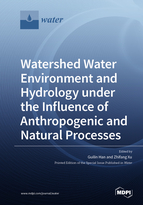Watershed Water Environment and Hydrology under the Influence of Anthropogenic and Natural Processes
A special issue of Water (ISSN 2073-4441). This special issue belongs to the section "Water Quality and Contamination".
Deadline for manuscript submissions: closed (31 January 2022) | Viewed by 21226
Special Issue Editors
Interests: hydrology; hydro-geochemistry; water chemistry; water quality; aquatic geochemistry; isotopic geochemistry
Special Issues, Collections and Topics in MDPI journals
Special Issue Information
Dear Colleagues,
The imbalance between water requirements and unevenly distributed water resources has become one of the most vital limiting factors for regional and even global sustainable development. In the context of the globalization of environmental change, how to identify and characterize water quality and contamination (including pollution levels, sources of pollutants, and influencing factors) is most important to realize high-efficiency water environmental management and sustainable use of water resources. Watersheds are the most important water resource unit in surface systems, supporting social and economic development in most parts of the world. However, the water eco-environments at different watershed scales pose many challenges for protection and management over the world. Accurate assessment of the transformation and migration of nutrients and other pollutants at different watershed scales is a critical challenge due to the different strengths of influence of anthropogenic and natural processes. By studying the biogeochemical cycle of substances and sources of pollutants in the water environment (e.g., rivers, reservoirs, and subterranean rivers) at watershed scale, combined with hydrology methods, the mechanism of ecological environment changes at watershed scale can be explored under the influence of both anthropogenic and natural processes. Generally, human activities, such as agricultural production, urban sewage, industrial discharge, and mining in the watershed are the main sources of pollutants in the water environment, and natural processes (mainly rock weathering) are also important factors controlling the water chemistry of watersheds. Meanwhile, in addition to natural hydrological processes, reservoir and dam construction (water conservancy projects) along with land use change are also important factors affecting material migration and transformation in the watershed water environment. With this Special Issue, we aim to promote the publication of papers dealing with watershed water environments and hydrology under the influence of anthropogenic and natural processes, mainly focusing on the quality and contamination of water bodies and their influencing factors. This Special Issue plans to share innovative/new ideas on the watershed water environment from different perspectives across the field. This topic could be addressed from several different perspectives:
1) The evolution of watershed water ecological and environmental quality impacted by both anthropogenic and natural processes.
2) The biogeochemical cycling of elements or pollutants driven by human activities and hydrological factors at watershed scale.
3) The identification and quantification of sources of pollutants in watershed water environments.
4) The assessment of ecological risk and human health risk of pollutants in the water environment at different watershed scales.
Prof. Dr. Guilin Han
Prof. Dr. Zhifang Xu
Guest Editors
Manuscript Submission Information
Manuscripts should be submitted online at www.mdpi.com by registering and logging in to this website. Once you are registered, click here to go to the submission form. Manuscripts can be submitted until the deadline. All submissions that pass pre-check are peer-reviewed. Accepted papers will be published continuously in the journal (as soon as accepted) and will be listed together on the special issue website. Research articles, review articles as well as short communications are invited. For planned papers, a title and short abstract (about 100 words) can be sent to the Editorial Office for announcement on this website.
Submitted manuscripts should not have been published previously, nor be under consideration for publication elsewhere (except conference proceedings papers). All manuscripts are thoroughly refereed through a single-blind peer-review process. A guide for authors and other relevant information for submission of manuscripts is available on the Instructions for Authors page. Water is an international peer-reviewed open access semimonthly journal published by MDPI.
Please visit the Instructions for Authors page before submitting a manuscript. The Article Processing Charge (APC) for publication in this open access journal is 2600 CHF (Swiss Francs). Submitted papers should be well formatted and use good English. Authors may use MDPI's English editing service prior to publication or during author revisions.
Keywords
- watershed water environment
- river pollution
- element cycle
- source identification
- agriculture
- urban sewage
- industrial discharge
- weathering
- water–air interface







